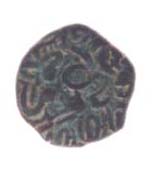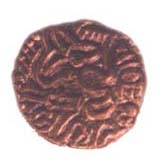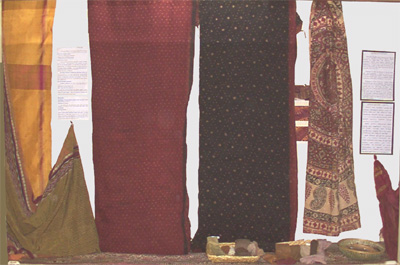|

Before Treatment
|
Conservation of Copper Coins/Objects
Coins were made out of the coinage metals such as gold, silver, copper and
their alloys like electrum, bronze, brass. They were kept buried under soil and stored in copper
vessels. Now, they are received as treasure-trove finds. Due to corrosion of the vessel as well as
coins, the coins are found stuck together appearing bluish green.
These coins are cleaned with an alkaline solution of Rochelle salt (15 gms of
Rochelle salt +5 gms of sodium hydroxide+80 gms of water). The corrosion products are removed and the
copper coins appear red. The red cupric oxide corrosion is removed by soaking the coins in 10% citric
acid, washed well to remove the salts, dried and a preservative coating of 2% poly vinyl acetate in
acetone is provided. By this method the aesthetic look of the objects are lost. |

After Treatment |

|
Conservation of Textiles
Textiles are woven out of natural and synthetic fibres. The designs are
created by weaving, dyeing, printing or painting. The dyes may be natural (mineral or organic dyes)
and man-made synthetic materials. The ancient textiles have only natural dyes. Textiles are normally
affected by moisture, biological agents, mishandling, vandalism, stains etc. The tears are mended by
darning if the textile is fairly in good condition and the fibres are strong. In case the fibres are
weak, then the textile should be lined with similar cloth and stitched with weak thread. Very fragile
textile may be mended with similar cloth and pasted with the help of 20% solution of poly vinyl
acetate in acetone and pressed. Some times old textiles are lined with similar cloth and stitching
with weak threads to avoid tear in the textile. |
|
|
|
|